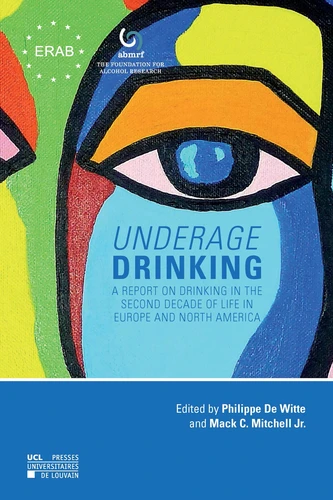Underage Drinking. A Report on Drinking in the Second Decade of Life in Europe and North America
Par : ,Formats :
Disponible dans votre compte client Decitre ou Furet du Nord dès validation de votre commande. Le format Multi-format est :
- Pour les liseuses autres que Vivlio, vous devez utiliser le logiciel Adobe Digital Edition. Non compatible avec la lecture sur les liseuses Kindle, Remarkable et Sony
 , qui est-ce ?
, qui est-ce ?Notre partenaire de plateforme de lecture numérique où vous retrouverez l'ensemble de vos ebooks gratuitement
Pour en savoir plus sur nos ebooks, consultez notre aide en ligne ici
- Nombre de pages220
- FormatMulti-format
- ISBN978-2-87558-090-0
- EAN9782875580900
- Date de parution18/08/2017
- Protection num.NC
- Infos supplémentairesMulti-format incluant PDF avec W...
- ÉditeurPresses universitaires de Louvai...
Résumé
The complexity and importance of underage drinking prompted ERAB and ABMRF to initiate a state of the art review. It explores the extent of underage drinking across Europe and North America, as well as our current understanding of factors that increase the risk of this behaviour and potentially effective evidence-based approaches to prevent underage drinking. Unfortunately, the problem is complex and a single solution or policy to prevent underage drinking does not exist.
Nevertheless, a number of strategies are effective in some circumstances and warrant further study in different populations. Preventing risky drinking requires understanding of the important influence of family and peers. It is also important to recognize that some genetic traits like impulsivity, anxiety, sensation seeking and emotional dysregulation can also influence harmful drinking. These aspects (family and peers and genetic influence) are affected by cultural and environmental influences which, in turn, can influence each other.
The overall goal of this project was to develop a set of recommendations that could be used by public health departments and key stakeholders in the individual countries that make up Europe and the United States and Canada. It is clear that a single solution to this problem cannot be identified, given the different cultural backgrounds. In addition to providing a menu of effective strategies, recommendations on the best method for applying them in different cultural settings are included.
Although individual interventions may have low efficacy when used in isolation, combining several interventions may improve overall effectiveness.
Nevertheless, a number of strategies are effective in some circumstances and warrant further study in different populations. Preventing risky drinking requires understanding of the important influence of family and peers. It is also important to recognize that some genetic traits like impulsivity, anxiety, sensation seeking and emotional dysregulation can also influence harmful drinking. These aspects (family and peers and genetic influence) are affected by cultural and environmental influences which, in turn, can influence each other.
The overall goal of this project was to develop a set of recommendations that could be used by public health departments and key stakeholders in the individual countries that make up Europe and the United States and Canada. It is clear that a single solution to this problem cannot be identified, given the different cultural backgrounds. In addition to providing a menu of effective strategies, recommendations on the best method for applying them in different cultural settings are included.
Although individual interventions may have low efficacy when used in isolation, combining several interventions may improve overall effectiveness.
The complexity and importance of underage drinking prompted ERAB and ABMRF to initiate a state of the art review. It explores the extent of underage drinking across Europe and North America, as well as our current understanding of factors that increase the risk of this behaviour and potentially effective evidence-based approaches to prevent underage drinking. Unfortunately, the problem is complex and a single solution or policy to prevent underage drinking does not exist.
Nevertheless, a number of strategies are effective in some circumstances and warrant further study in different populations. Preventing risky drinking requires understanding of the important influence of family and peers. It is also important to recognize that some genetic traits like impulsivity, anxiety, sensation seeking and emotional dysregulation can also influence harmful drinking. These aspects (family and peers and genetic influence) are affected by cultural and environmental influences which, in turn, can influence each other.
The overall goal of this project was to develop a set of recommendations that could be used by public health departments and key stakeholders in the individual countries that make up Europe and the United States and Canada. It is clear that a single solution to this problem cannot be identified, given the different cultural backgrounds. In addition to providing a menu of effective strategies, recommendations on the best method for applying them in different cultural settings are included.
Although individual interventions may have low efficacy when used in isolation, combining several interventions may improve overall effectiveness.
Nevertheless, a number of strategies are effective in some circumstances and warrant further study in different populations. Preventing risky drinking requires understanding of the important influence of family and peers. It is also important to recognize that some genetic traits like impulsivity, anxiety, sensation seeking and emotional dysregulation can also influence harmful drinking. These aspects (family and peers and genetic influence) are affected by cultural and environmental influences which, in turn, can influence each other.
The overall goal of this project was to develop a set of recommendations that could be used by public health departments and key stakeholders in the individual countries that make up Europe and the United States and Canada. It is clear that a single solution to this problem cannot be identified, given the different cultural backgrounds. In addition to providing a menu of effective strategies, recommendations on the best method for applying them in different cultural settings are included.
Although individual interventions may have low efficacy when used in isolation, combining several interventions may improve overall effectiveness.




